Urban Texture Identification and Characteristic Analysis Based on Percolation Theory—A Case Study of the Second Ring Road Area in Wuhan City
Abstract
1. Introduction
2. Study Area and Data Sources
2.1. Study Area
2.2. Data Sources
3. Methods
3.1. Methods for Construction of Complex Networks of Urban Buildings
3.2. Urban Texture Identification Method Based on Percolation Model
3.3. Comprehensive Index System for Urban Texture Measurement
3.4. Methods of Measuring Urban Texture Toughness
4. Results
4.1. Results of Building Complex Network Construction
4.2. Identification Results of Texture Clusters at Different Scale Levels
4.3. Characterization of the Hierarchical Evolution of Texture Clusters
4.4. Quantitative Measurement of Spatial Heterogeneity of Texture Clusters
4.5. Measurement of Texture Toughness
5. Discussion
5.1. The Rational Organization of the Urban Texture
5.2. Suggestions on Urban Texture Optimization in Wuhan
6. Conclusions and Outlook
6.1. Conclusions
- (1)
- Different types of urban texture exhibit distinct morphological patterns at different scales, and their evolution varies with scale changes. The old urban texture exhibits small-scale dependent characteristics, emerging in large quantities at small scales and reaching a certain scale and completeness first. The contemporary urban texture experiences fragmentation at small scales and demonstrates regionalization characteristics at larger scales.
- (2)
- The texture of the old city is highly sensitive to scale changes, expanding rapidly at small scales. It has higher texture coverage, a larger number of clusters, and the maximum texture size compared to other districts. In contemporary urban districts, the size of the texture clusters and differences in cluster size show less variation across scales. The dominant process of texture integration shifts from the old city area to the modern city area as the scale changes. The old city area maintains its texture integrity and internal connectivity at small scales, while the integration process for the contemporary city texture occurs at larger scales and slower speeds.
- (3)
- Urban areas consist of multiple texture types, and the same texture type exhibits cross-area agglomeration and distribution characteristics. There is a certain correlation between the morphological indicators of texture patches, and the morphological characteristics of the same texture type are not completely similar. The size of the texture clusters emerging from a specific scale is determined by various indicator systems. Large-scale texture clusters typically exhibit a high building density, low number of building floors, regular building shape, and high fragmentation.
- (4)
- The connectivity of the urban texture in the multi-scale hierarchical network determines its toughness in resisting external disturbances. The urban texture of the old city area demonstrates strong connectivity in the multi-scale hierarchical network and usually appears as the largest or second-largest cluster, indicating strong textural toughness. The contemporary urban texture, characterized by large-scale building spacing and urban road blockages, weakens the spatial connection between the interior and exterior of the texture, resulting in poor texture toughness.
6.2. Outlook
Author Contributions
Funding
Data Availability Statement
Conflicts of Interest
References
- Liu, S.; Yu, Q.; Wei, C. Spatial-Temporal Dynamic Analysis of Land Use and Landscape Pattern in Guangzhou, China: Exploring the Driving Forces from an Urban Sustainability Perspective. Sustainability 2019, 11, 6675. [Google Scholar] [CrossRef]
- Wu, J.; Yang, S.; Zhang, X. Interaction Analysis of Urban Blue-Green Space and Built-Up Area Based on Coupling Model—A Case Study of Wuhan Central City. Water 2020, 12, 2185. [Google Scholar] [CrossRef]
- DeVerteuil, G. Urban inequality revisited: From the corrugated city to the lopsided city. Dialogues Urban Res. 2023, 1, 252–270. [Google Scholar] [CrossRef]
- Richard, K. Changing urban fabrics: Thinking through the lopsided city. Dialogues Urban Res. 2023, 1, 288–292. [Google Scholar]
- Leila, A. The semantic value of historical monuments as cultural heritage in urban texture: Cases of Ankara Castle and Anıtkabir. J. Archit. Conserv. 2022, 28, 197–216. [Google Scholar]
- Li, X.; Hui, E.C.M.; Chen, T.; Lang, W.; Guo, Y. From habitat III to the new urbanization agenda in China: Seeing through the practices of the “Three old renewals” in Guangzhou. Land Use Policy 2019, 87, 513–522. [Google Scholar] [CrossRef]
- Whitehand, J.W.R.; Gu, K.; Whitehand, S.M.; Zhang, J. Urban morphology and conservation in China. Cities 2011, 28, 171–185. [Google Scholar] [CrossRef]
- Wang, J. Problems and solutions in the protection of historical urban areas. Front. Archit. Res. 2012, 1, 40–43. [Google Scholar] [CrossRef]
- Said, S.Y.; Aksah, H.; Ismail, E.D. Heritage Conservation and Regeneration of Historic Areas in Malaysia. Procedia Soc. Behav. Sci. 2013, 105, 418–428. [Google Scholar] [CrossRef]
- Tsai, Y.H. Apply urban morphology to study Tainan commercial district fabrics. Sustain. City 2016, 204, 161–170. [Google Scholar]
- Salingaros, N.A. Complexity and Urban Coherence. J. Urban Des. 2000, 3, 291–316. [Google Scholar] [CrossRef]
- Batty, M.; Longley, M. Fractal Cities—A Geometry of Form and Function; Academic Press: London, UK, 1994. [Google Scholar]
- Tara, A.; Patuano, A.; Lawson, G. Between 2D and 3D: Studying Structural Complexity of Urban Fabric Using Voxels and LiDAR-Derived DSMs. Fractal Fract. 2021, 5, 227. [Google Scholar] [CrossRef]
- Chadwick, G.F. A Systems View of Planning; Pergamon Press: Oxford, UK, 1971. [Google Scholar]
- Portugali, J. Self-Organization and the City; Springer: New York, NY, USA, 2000. [Google Scholar]
- Jacobs, J. The Death and Life of Great American Cities; Random House: New York, NY, USA, 1961. [Google Scholar]
- Vaughan, J.; Ostwald, M.J. Using fractal analysis to compare the characteristic complexity of nature and architecture: Re-examining the evidence. Archit. Sci. Rev. 2010, 53, 323–332. [Google Scholar] [CrossRef]
- Salingaros, N.A. Connecting the fractal city. In Proceedings of the Keynote Speech, 5th Biennial of Towns and Town Planners in Europe, Barcelona, Spain, 10–12 April 2003. [Google Scholar]
- Porta, S.; Crucitti, P.; Latora, V. The network analysis of urban streets: A primal approach. Environ. Plan. B Plan. Des. 2006, 33, 705–725. [Google Scholar] [CrossRef]
- Perry, S. The Unfinished Landscape—Fractal Geometry and the Aesthetic of Ecological Design. Ph.D. Thesis, Queensland University of Technology, Brisbane City, Australia, 2012. [Google Scholar]
- Salingaros, N.A.; West, B.J. A universal rule for the distribution of sizes. Environ. Plan. B Plan. Des. 1999, 26, 909–923. [Google Scholar] [CrossRef]
- Carolina, Q.R.; Felipe, J. Urban Fabrics to Eco-Friendly Blue–Green for Urban Wetland Development. Sustainability 2021, 13, 13745. [Google Scholar]
- Tong, M. How urban fabric can help sustain the vitality of cities. Urban Plan. Forum 2014, 216, 85–96. [Google Scholar]
- Li, X.; Cheng, S.; Lv, Z.; Song, H.; Jia, T.; Lu, N. Data analytics of urban fabric metrics for smart cities. Future Gener. Comput. Syst. 2020, 107, 871–882. [Google Scholar] [CrossRef]
- Pont, M.B.; Haupt, P. The spacemate: Density and the typomorphology of the urban fabric. In Urbanism Laboratory for Cities and Regions: Progress of Research Issues in Urbanism; IOS Press: Amsterdam, The Netherlands, 2005. [Google Scholar]
- Cohen, N. Urban Planning Conservation and Preservation; Wang, S., Translator; China Machine Press: Beijing, China, 2004. [Google Scholar]
- Cataldi, G.; Maffei, G.; Vaccaro, P. Saverio Muratori and the Italian school of planning typology. Urban Morphol. 2002, 6, 3–14. [Google Scholar] [CrossRef]
- Whitehand, J. From Como to Alnwick: In pursuit of Caniggia and Conzen. Urban Morphol. 2003, 7, 69–72. [Google Scholar] [CrossRef]
- Cataldi, G. From Muratori to Caniggia: The origins and development of the Italian school of design typology. Urban Morphol. 2003, 7, 19–34. [Google Scholar] [CrossRef]
- Monteiro, C.; Pinho, P. Comparing approaches in urban morphology. J. Urban. 2022, 15, 491–518. [Google Scholar] [CrossRef]
- Chen, F. One New Framework of Study:Application of Urban Typo-morphology to China. Archit. J. 2010, 4, 85–90. [Google Scholar]
- Araldi, A.; Fusco, G. Decomposing and Recomposing Urban Fabric: The City from the Pedestrian Point of View. In Computational Science and Its Applications—ICCSA; Gervasi, O., Murgante, B., Misra, S., Borruso, G., Torre, C.M., Rocha, A.M.A.C., Taniar, D., Apduhan, B.O., Stankova, E., Cuzzocrea, A., Eds.; Springer: New York, NY, USA, 2017; Volume 10407, pp. 365–376. [Google Scholar]
- Marzot, N. The Study of Urban Form in Italy. Urban Morphol. 2002, 6, 59–73. [Google Scholar] [CrossRef]
- Levy, A. Urban morphology and the problem of the modern urban fabric: Some questions for research. Urban Morphol. 1999, 3, 79–85. [Google Scholar] [CrossRef]
- Kropf, K. Urban Tissue and the Character of Towns. Urban Des. Int. 1996, 1, 247–263. [Google Scholar] [CrossRef]
- He, Y.; Deng, W. Research on the prototype and types of architectural texture in historic district. City Plan. Rev. 2014, 38, 57–62. [Google Scholar]
- Batty, M. Cities as Complex Systems: Scaling, Interaction, Networks, Dynamics and Urban Morphologies. In Encyclopedia of Complexity and Systems Science; Meyers, R., Ed.; Springer: New York, NY, USA, 2009. [Google Scholar]
- Fang, Y.; Liu, J. Urban fabric organization based on complex system theory. City Plan. Rev. 2008, 250, 32–37. [Google Scholar]
- Dong, J.; Li, L.; Han, D. New Quantitative Approach for the Morphological Similarity Analysis of Urban Fabrics Based on a Convolutional Autoencoder. IEEE Access. 2019, 7, 138162–138174. [Google Scholar] [CrossRef]
- Moudon, A.V. Urban morphology as an emerging interdisciplinary field. Urban Morphol. 1997, 1, 3–10. [Google Scholar] [CrossRef]
- Chen, F. The Role of Typomorphology in Sustaining the Cultural Identity of Chinese Cities: The Case Study of Nanjing, China. Ph.D. Thesis, Department of Architecture, University of Strathclyde, Glasgow, UK, 2009. [Google Scholar]
- Chen, F. Interpreting urban micromorphology in China: Case studies from Suzhou. Urban Morphol. 2012, 16, 133–148. [Google Scholar] [CrossRef]
- Hall, A.C. Bridging the gap: Applying urban morphology to successful planning practice. Urbn Morphol. 2008, 12, 54–57. [Google Scholar] [CrossRef]
- Whitehand, J.W.R. British urban morphology: The Conzenian tradition. Urban Morphol. 2001, 5, 103–109. [Google Scholar] [CrossRef]
- Xu, R. Research on Nanjing Ancient Urban Morphology Evolution Based on Climate Adaptability. IOP Conf. Ser. Mater. Sci. Eng. 2020, 794, 012021. [Google Scholar] [CrossRef]
- Chen, F.; Romice, O. Preserving the cultural identity of Chinese cities in urban design through a typomorphological approach. Urbana Des. Int. 2009, 14, 36–54. [Google Scholar] [CrossRef]
- Gil, J.; Beirão, J.N.; Montenegro, N.; Duarte, J.P. On the discovery of urban typologies: Data mining the many dimensions of urban form. Urban Morphol. 2012, 16, 27–40. [Google Scholar] [CrossRef]
- Hijazi, I.; Li, X.; Koenig, R.; Schmit, G.; Meouche, R.E.; Lv, Z.; Abune’meh, M. Measuring the homogeneity of urban fabric using 2D geometry data. Environ. Plan. B Urban Anal. City Sci. 2016, 44, 1097–1121. [Google Scholar] [CrossRef]
- Zhang, P.; Ghosh, D.; Park, S. Spatial measures and methods in sustainable urban morphology: A systematic review. Landsc. Urban Plan. 2023, 237, 104776. [Google Scholar] [CrossRef]
- Labetski, A.; Vitalis, S.; Biljecki, F.; Ohori, K.A.; Stoter, J. 3D building metrics for urban morphology. Int. J. Geogr. Inf. Sci. 2023, 37, 36–67. [Google Scholar] [CrossRef]
- Ren, L.; Cao, Y. GIS-based viewshed analysis on the conservation planning of historic towns: The case study of Xinchang, Shanghai. Int. Arch. Photogramm. Remote Sens. Spatial Inf. Sci. 2021, XLVI-M-1, 609–616. [Google Scholar] [CrossRef]
- Mirzaee, S.; Özgun, O.; Ruth, M.; Binita, K.C. Neighborhood-scale sky view factor variations with building density and height: A simulation approach and case study of Boston. Urban Clim. 2018, 26, 95–108. [Google Scholar] [CrossRef]
- Filomena, G.; Verstegen, J.A.; Manley, E. A computational approach to ‘The Image of the City’. Cities 2019, 89, 14–25. [Google Scholar] [CrossRef]
- Ostwald, J.M.; Lee, H. Computational Analytical Methods for Buildings and Cities: Space Syntax and Shape Grammar. Buildings 2023, 13, 1613. [Google Scholar] [CrossRef]
- Lyu, Y.; Malek, M.I.A.; Ja’afar, N.H.; Sima, Y.; Han, Z.; Liu, Z. Unveiling the potential of space syntax approach for revitalizing historic urban areas: A case study of Yushan Historic District, China. Front. Archit. Res. 2023, 12, 1144–1156. [Google Scholar] [CrossRef]
- Li, X.; Lv, Z.; Zheng, Z.; Zhong, C.; Hijazi, I.H.; Cheng, S. Assessment of lively street network based on geographic information system and space syntax. Multimed. Tools Appl. 2015, 76, 17801–17819. [Google Scholar] [CrossRef]
- Christensen, K.; Moloney, N.R. Complexity and Criticality; Imperial College Press: London, UK, 2005; Volume 1. [Google Scholar]
- Li, M.; Liu, R.; LÜ, L.; Hu, M.; Xu, S.; Zhang, Y. Percolation on complex networks: Theory and application. Phys. Rep. 2021, 907, 1–68. [Google Scholar] [CrossRef]
- Molinero, C.; Murcio, R.; Arcaute, E. The angular nature of road networks. Sci. Rep. 2017, 7, 4312. [Google Scholar] [CrossRef] [PubMed]
- Shen, Y.; Xu, Y.; Liu, Y. Urban texture analysis from the perspective of network percolation. Urban Plan. Forum 2021, 265, 40–48. [Google Scholar]
- Deng, H.; Song, F.; Cai, H. Urban tissue and walkability morphological analysis on the essential characteristics of urban walkable space. Archit. J. 2013, 6, 8–13+7. [Google Scholar]
- Zhang, Y.; Guo, L. Network Percolation Based on Complex Network. J. Netw. 2013, 8, 1874–1881. [Google Scholar] [CrossRef]
- Xing, Z.; Guo, W. A New Urban Space Analysis Method Based on Space Syntax and Geographic Information System Using Multisource Data. ISPRS Int. J. Geo-Inf. 2022, 11, 297. [Google Scholar] [CrossRef]
- Yang, H. Multiple Definitions and Analysis of Building Height. Urban. Archit. 2023, 20, 210–213. [Google Scholar]
- Zhang, P. Spatial fluctuation of urban architecture. J. Arid. Land Resour. Environ. 2016, 30, 51–57. [Google Scholar]
- Zhang, L.; Ren, J. Percolation theory, method, progress, and existing problems. Chin. J. Nat. 2019, 41, 119–131. [Google Scholar]
- Liu, Q.; Ding, W. The graphical method and its significance in the study of urban texture form. Architect 2012, 01, 5–12. [Google Scholar]
- Li, X.; Cheng, S.; Li, K.; Chen, C. Data based interpretation of urban fabric: The case of Hankou riverside area. Archit. J. 2017, S1, 7–13. [Google Scholar]
- Basaraner, M.; Cetinkaya, S. Performance of shape indices and classification schemes for characterising perceptual shape complexity of building footprints in GIS. Int. J. Geogr. Inf. Sci. 2017, 31, 1952–1977. [Google Scholar] [CrossRef]
- Saura, S.; Carballal, P. Discrimination of native and exotic forest patterns through shape irregularity indices: An analysis in the landscapes of Galicia, Spain. Landsc. Ecol. 2004, 19, 647–662. [Google Scholar] [CrossRef]
- Li, Z.; Hu, D. Characterization of three-dimensional architectural form change of part of Beijing’s central city from 1990 to 2019. Ecol. Sci. 2023, 42, 49–55. [Google Scholar]
- Miao, C.; Yu, S.; Hu, Y.; Zhang, H.; He, X.; Chen, W. Review of methods used to estimate the sky view factor in urban street canyons. Build. Environ. 2020, 168, 106497. [Google Scholar] [CrossRef]
- Böhner, J.; McCloy, K.R.; Strobl, J. SAGA: Analysis and Modelling Applications; Number 115; Goltze: Gottingen, Germany, 2006. [Google Scholar]
- Bernard, J.; Bocher, E.; Petit, G.; Palominos, S. Sky View Factor Calculation in Urban Context: Computational Performance and Accuracy Analysis of Two Open and Free GIS Tools. Climate 2018, 6, 60. [Google Scholar] [CrossRef]
- Salingaros, N.A. Urban Space and its Information Field. J. Urban Des. 1999, 4, 29–49. [Google Scholar] [CrossRef]
- Salingaros, N.A.; Liu, Y. Connecting the Fractal City. Urban Plan. Int. 2008, 23, 81–92. [Google Scholar]
- Wu, Y.; Chen, S. Study on Suture of Urban Texture Rupture: The Case of Ladies’ Street in Hefei. Archit. Cult. 2021, 01, 168–170. [Google Scholar]
- Andrés, R.L.J.; Daniel, N.C.; Teresa, P.C.M. Le Corbusier’s urbanism: An urban characterisation of his proposals for inner cities. Front. Archit. Res. 2021, 10, 701–714. [Google Scholar]
- Dupuy, G. L’Urbanisme Des Réseaux; Armand Colin: Paris, France, 1991. [Google Scholar]
- Krier, L. Architecture: Choice or Fate, and Reas Papadakis; Windsor: Berkshire, UK, 1998. [Google Scholar]
- Dupuy, G. Les Territoires de l’Automobile; Anthropos: Paris, France, 1995. [Google Scholar]
- Parsons, A. Urban Acupuncture: Marco Casagrande; University of Portsmouth: Hampshire, UK, 2010. [Google Scholar]
- Abdelmonem, G.M.; McWhinney, R. In search of common grounds: Stitching the divided landscape of urban parks in Belfast. Cities 2015, 44, 40–49. [Google Scholar] [CrossRef]
- Yang, J.; Wu, H.; Jin, T. Research on spatial morphology and scale texture of new district planning in China. Urban Plan. Int. 2017, 32, 34–42. [Google Scholar] [CrossRef]
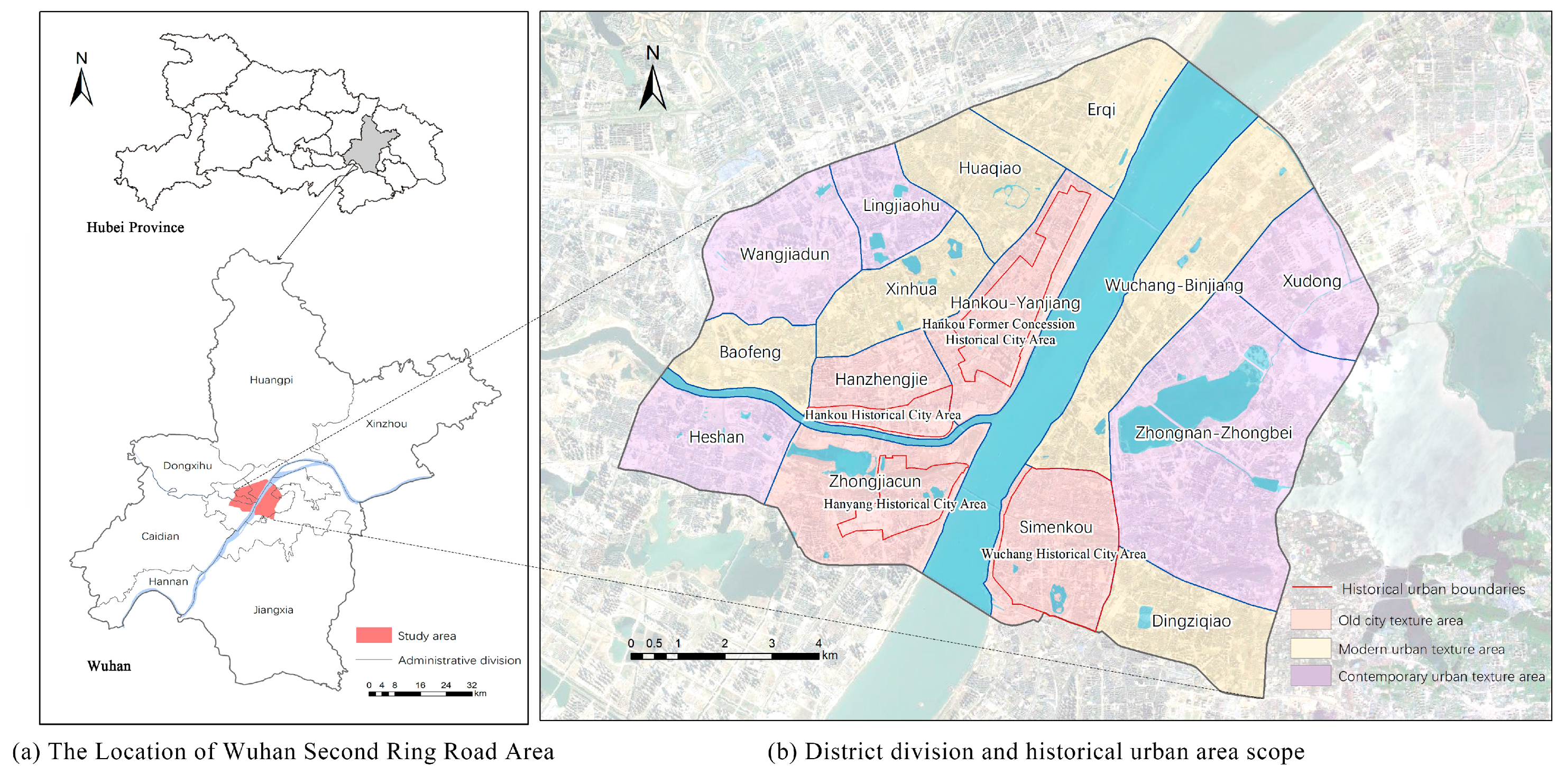



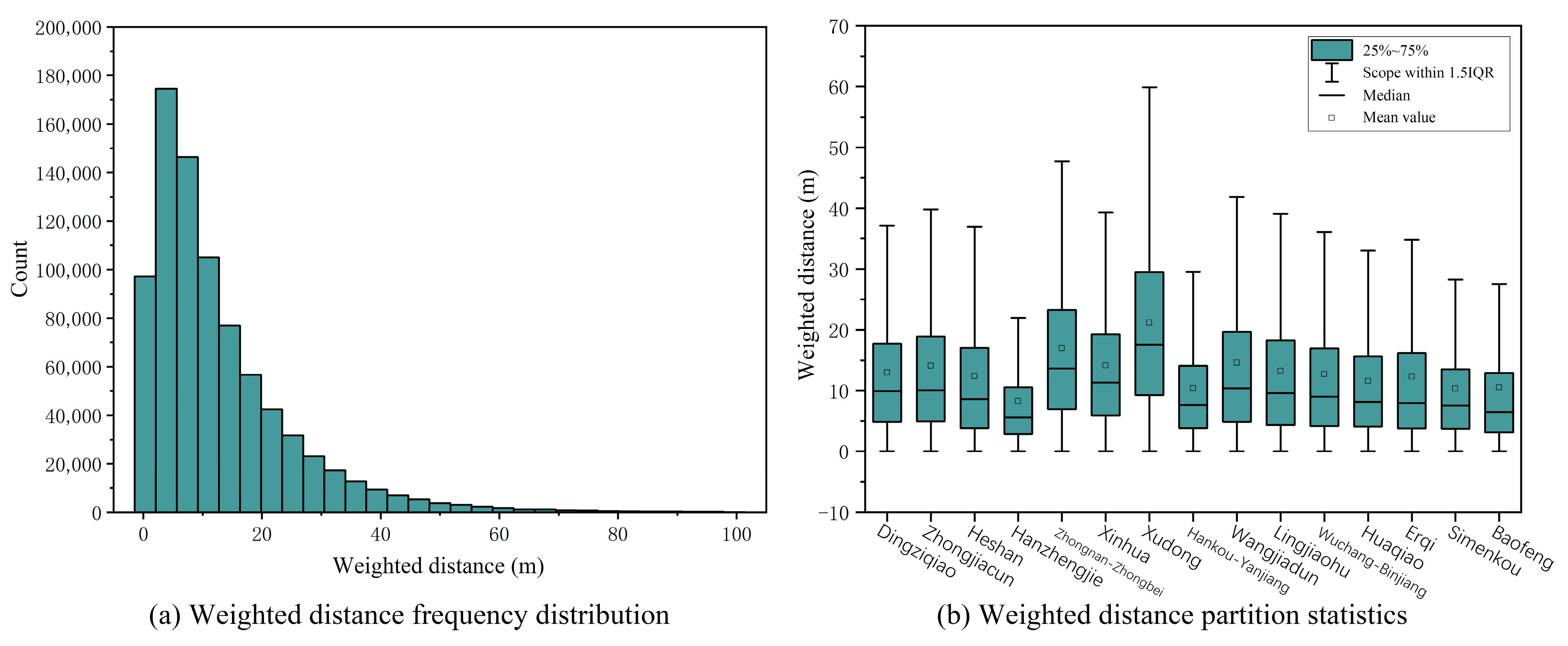

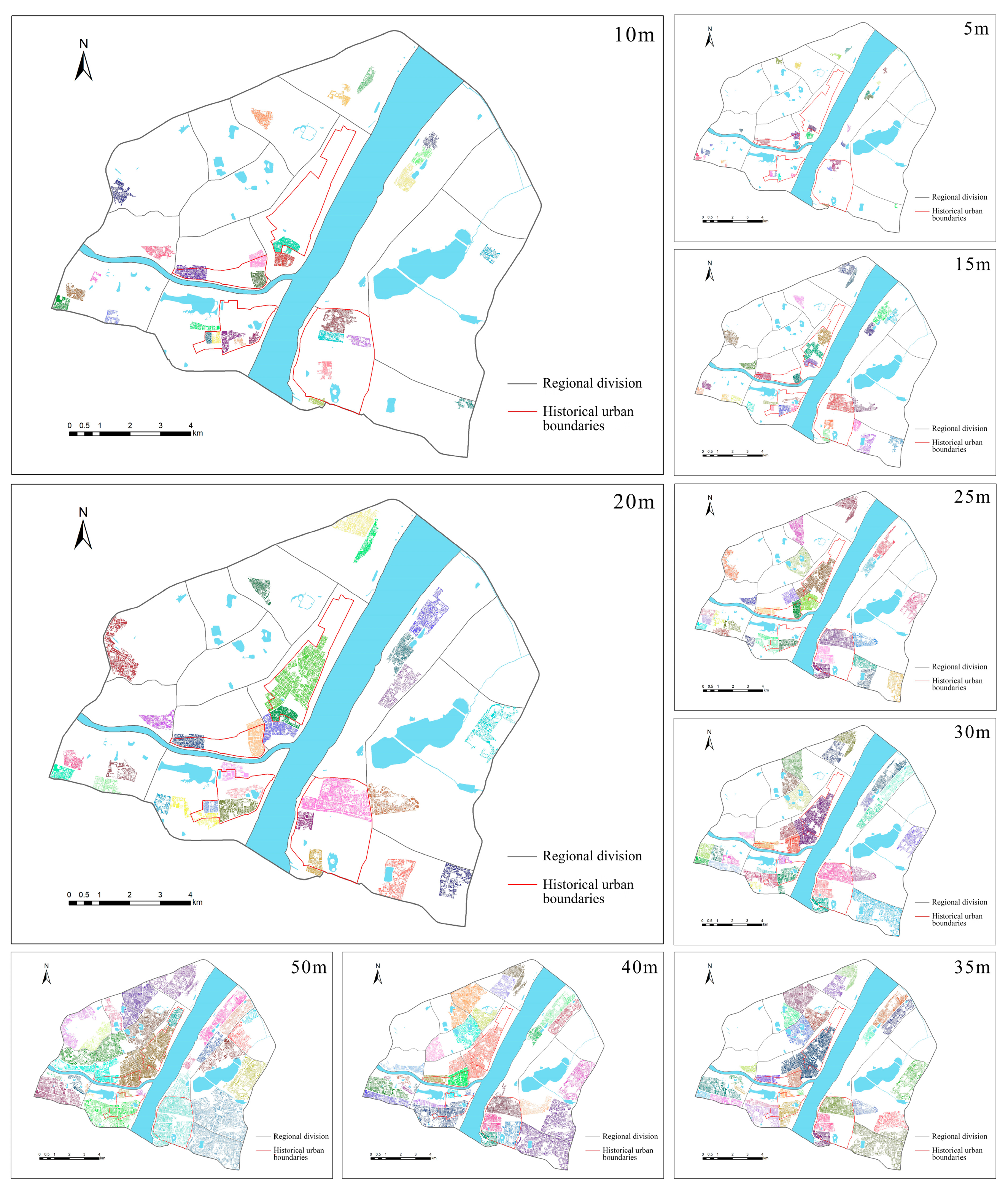
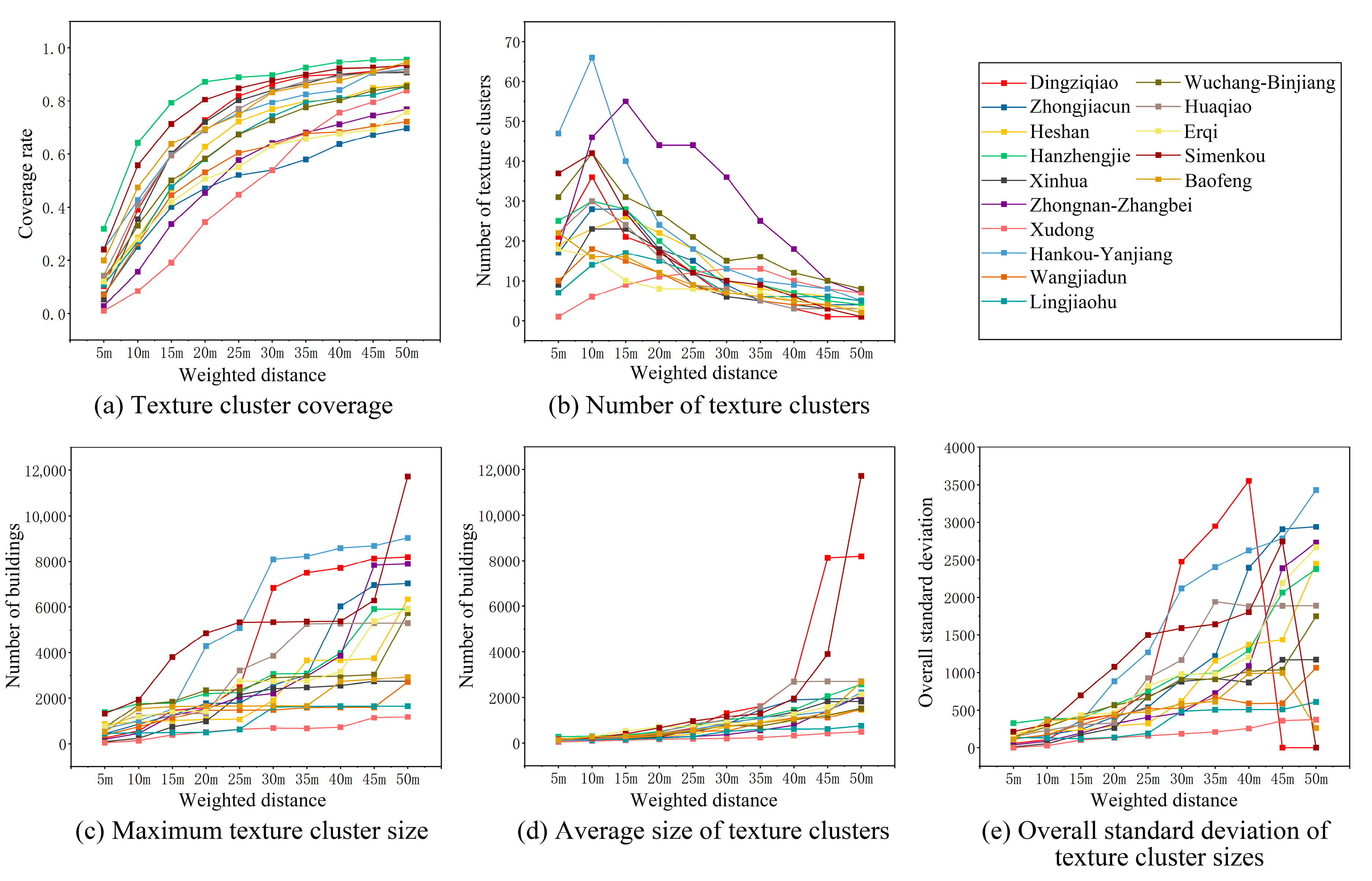
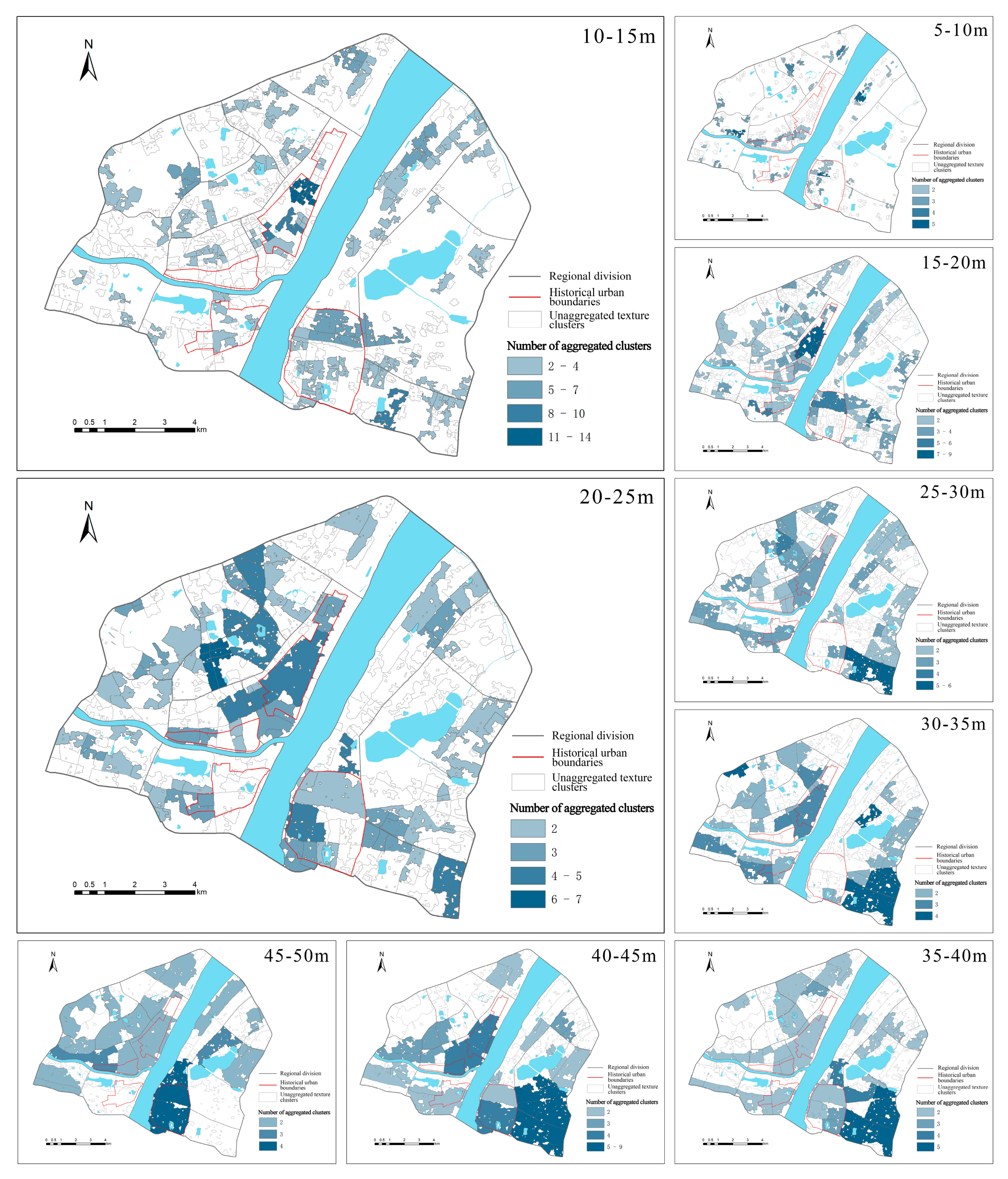
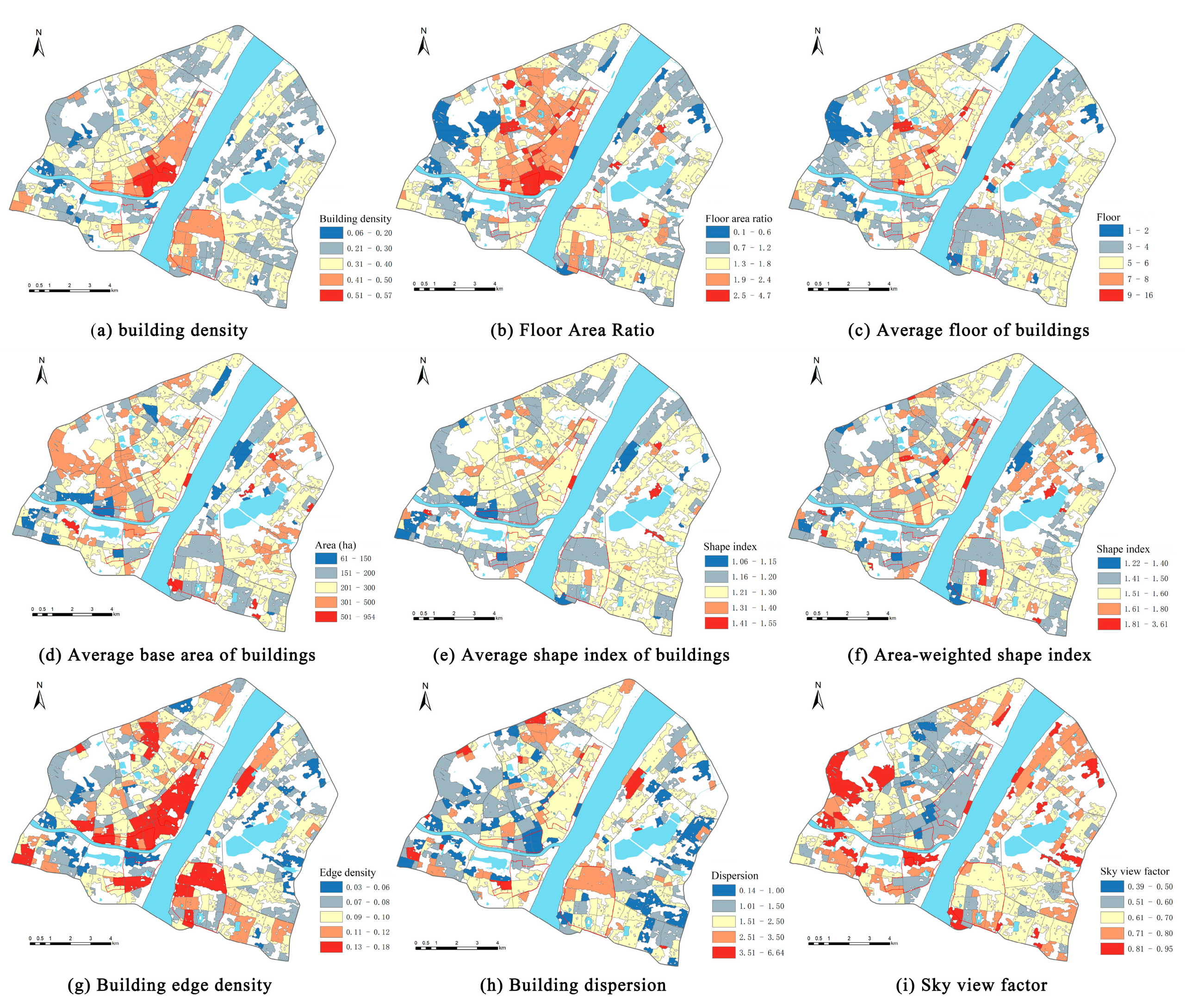

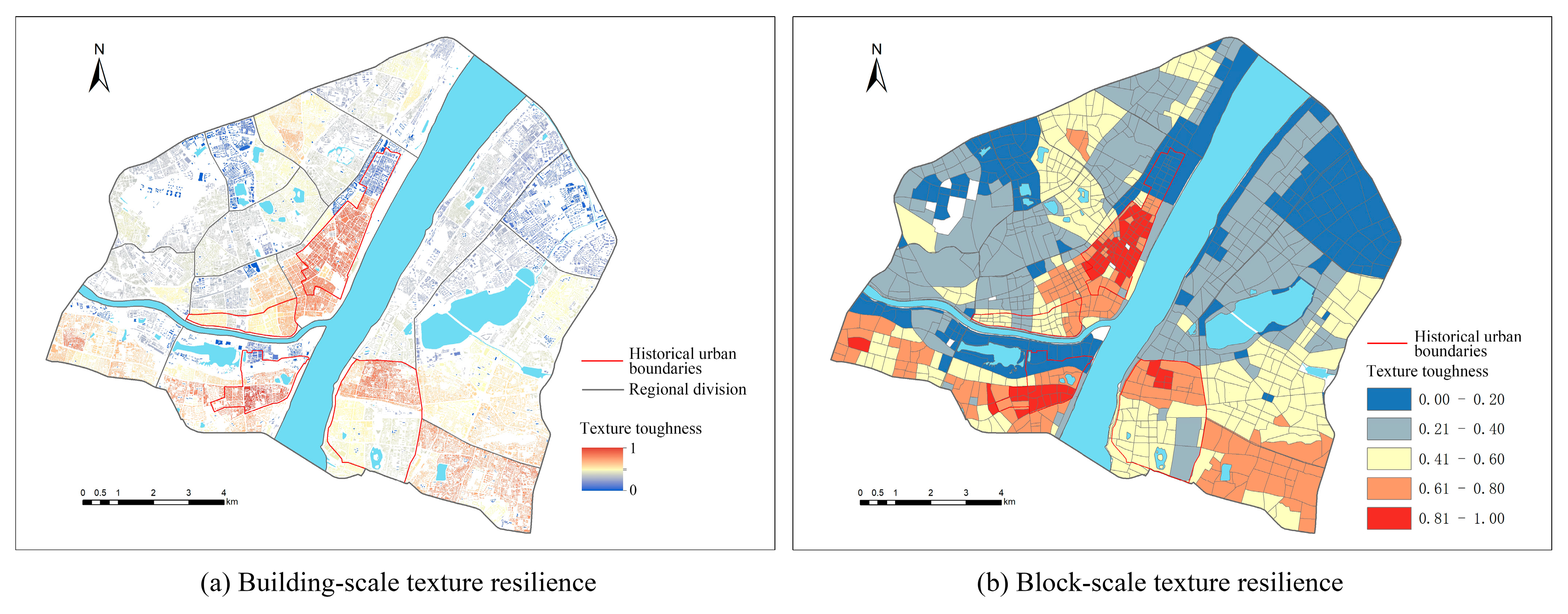
Disclaimer/Publisher’s Note: The statements, opinions and data contained in all publications are solely those of the individual author(s) and contributor(s) and not of MDPI and/or the editor(s). MDPI and/or the editor(s) disclaim responsibility for any injury to people or property resulting from any ideas, methods, instructions or products referred to in the content. |
© 2024 by the authors. Licensee MDPI, Basel, Switzerland. This article is an open access article distributed under the terms and conditions of the Creative Commons Attribution (CC BY) license (https://creativecommons.org/licenses/by/4.0/).
Share and Cite
Yang, S.; Zhan, Q.; Zhang, K.; Paryzat, H. Urban Texture Identification and Characteristic Analysis Based on Percolation Theory—A Case Study of the Second Ring Road Area in Wuhan City. Land 2024, 13, 717. https://doi.org/10.3390/land13050717
Yang S, Zhan Q, Zhang K, Paryzat H. Urban Texture Identification and Characteristic Analysis Based on Percolation Theory—A Case Study of the Second Ring Road Area in Wuhan City. Land. 2024; 13(5):717. https://doi.org/10.3390/land13050717
Chicago/Turabian StyleYang, Shen, Qingming Zhan, Kaili Zhang, and Hurex Paryzat. 2024. "Urban Texture Identification and Characteristic Analysis Based on Percolation Theory—A Case Study of the Second Ring Road Area in Wuhan City" Land 13, no. 5: 717. https://doi.org/10.3390/land13050717
APA StyleYang, S., Zhan, Q., Zhang, K., & Paryzat, H. (2024). Urban Texture Identification and Characteristic Analysis Based on Percolation Theory—A Case Study of the Second Ring Road Area in Wuhan City. Land, 13(5), 717. https://doi.org/10.3390/land13050717








